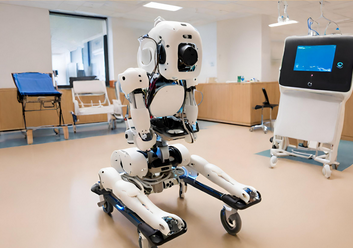In recent years, advancements in robotics have revolutionized numerous industries, with healthcare being a prominent beneficiary. Health robots in hospitals are transforming how medical services are delivered, improving patient outcomes, and streamlining operations. From assisting in surgeries to automating administrative tasks, these robots play a crucial role in enhancing the efficiency and effectiveness of modern healthcare systems. As technology continues to evolve, the integration of robotics in hospitals is set to redefine the future of medicine.
The Role of Health Robots in Hospitals
Surgical Assistance
Robotic systems like the Da Vinci Surgical System have brought unprecedented precision to operating rooms.
- Enhanced Precision: These robots assist surgeons in performing minimally invasive procedures with greater accuracy.
- Reduced Recovery Time: Patients undergoing robotic-assisted surgeries often experience shorter hospital stays and faster recovery times due to less invasive techniques.
- Improved Outcomes: The precision of robotic systems reduces complications, leading to better overall patient outcomes.
Patient Care and Monitoring
Health robots are increasingly used to provide personalized patient care:
- Nursing Robots: Robots like Moxi assist healthcare staff by delivering supplies, reducing their workload, and allowing them to focus more on patient care.
- Telepresence Robots: These robots enable doctors to consult with patients remotely, ensuring access to quality care regardless of location.
- Vital Monitoring: Advanced robots can continuously monitor patients’ vital signs and alert medical staff in case of emergencies.
Administrative Support
Robots are also streamlining hospital operations by automating repetitive administrative tasks:
- Medication Delivery: Robots efficiently deliver medications to different hospital units, minimizing human errors.
- Logistics Automation: Health robots help manage inventory, transport medical equipment, and maintain records, ensuring smooth hospital operations.
Benefits of Integrating Robots in Healthcare
Increased Efficiency
By handling repetitive tasks, robots free up time for healthcare professionals to focus on critical, patient-centered activities. This not only improves workflow but also enhances the quality of care.
Enhanced Safety
Health robots reduce the risk of human errors, particularly in medication administration and surgical procedures. Additionally, they are invaluable during infectious disease outbreaks, as they can minimize direct contact between patients and staff.
Accessibility and Equity
Robotic systems enable healthcare services to reach underserved populations. Telepresence robots, for instance, provide access to specialists in remote or rural areas where healthcare infrastructure may be limited.
Cost-Effectiveness
While the initial investment in robotics can be high, their long-term benefits include reduced operational costs, improved patient outcomes, and decreased hospital readmissions.
Subheading: Challenges and Ethical Considerations
Despite their advantages, the use of health robots in hospitals comes with challenges:
- High Costs: The implementation and maintenance of advanced robotic systems can be prohibitively expensive for some healthcare facilities.
- Training and Adaptation: Medical staff need comprehensive training to operate and interact with these robots effectively.
- Ethical Concerns: The increasing reliance on robots raises questions about patient privacy, data security, and the potential dehumanization of care.
The Future of Health Robots in Hospitals
AI and Machine Learning Integration
The integration of artificial intelligence and machine learning with robotics is set to enhance their capabilities further. For example:
- Predictive Analytics: AI-powered robots can analyze patient data to predict complications and recommend proactive interventions.
- Personalized Medicine: Robots equipped with AI can tailor treatments to individual patients, improving effectiveness.
Collaboration Between Humans and Robots
Future healthcare models envision seamless collaboration between robots and human professionals, combining the strengths of both to provide superior care. For example:
- Robots assisting nurses in physical tasks while they focus on emotional support.
- Collaborative robots (cobots) working alongside surgeons during complex procedures.
Broader Adoption Globally
As technology becomes more affordable, developing countries may adopt health robots in hospitals, bridging gaps in healthcare access and quality worldwide.
Conclusion
The integration of health robots in hospitals is a transformative step towards a more efficient, precise, and accessible healthcare system. By assisting in surgeries, improving patient care, and automating administrative tasks, these robots not only enhance operational efficiency but also elevate the quality of medical services. While challenges like costs and ethical considerations remain, advancements in technology are paving the way for innovative solutions. As the role of robotics in healthcare expands, hospitals worldwide can look forward to a future where robots work hand-in-hand with medical professionals to deliver exceptional care.

